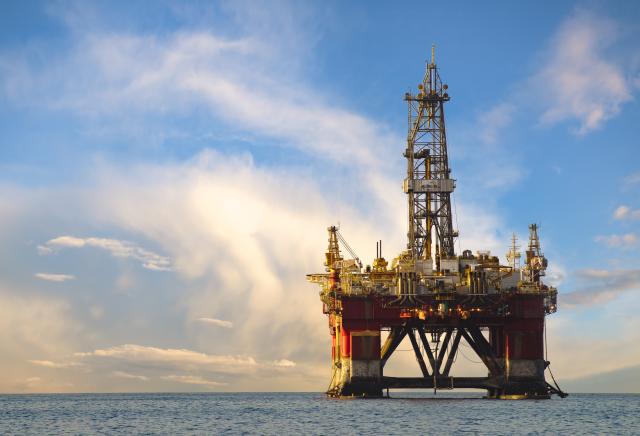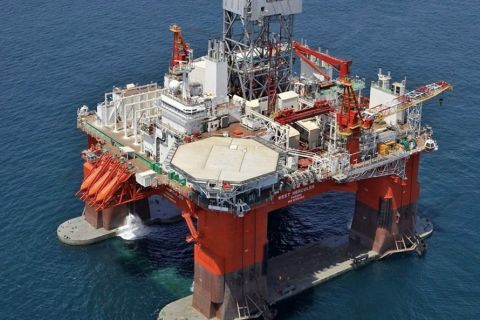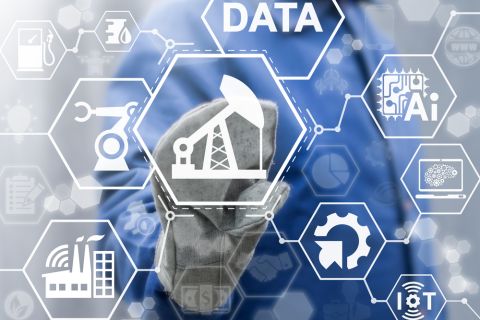
After surrendering their oil and natural gas contents, undersea production zones have room for large caches of carbon capture and storage. This technology is one of the things being studied by the Gulf Offshore Research Institute. (Source: Shutterstock.com)
In the heyday of Gulf of Mexico (GoM) oil and gas production, as many as 4,000 platforms speared its warm waters and silty bottoms, pumping hundreds of millions of barrels of black gold to coastal refineries. Today, less than half of those platforms—approximately 1,600—remain standing. Each year, about 175 more are hauled to scrapyards. A small amount of these are reefed.
Over the decades that these structures housed people and gargantuan machinery on the surface, a strange thing happened below the waterline. Marine life—plant and animal—congregated and multiplied in the safety and stability of these massive structures. Many types of corals, red snapper, sea turtles and many other species found homes there.
Removing these retired platforms would destroy their attached habitats, disrupting and killing millions of marine plants and animals. Instead, a strong case can be made for restoring and repurposing not only the platforms, but also the wells.
Research shows that these platforms can be used for a multitude of purposes beyond their days of producing oil and gas to help meet the nation’s nutritional and energy needs. At the same time, they can be used to mitigate climate change. With oil and gas activities in the GoM declining, ramping up the “Blue Economy” by transitioning these platforms makes sense.
In short, the ESG possibilities are endless.
The battle of the bureaus
President Biden wants the U.S. to produce 30 GW of electricity from offshore wind by 2030—a moon shot effort. The GoM platforms can certainly play a significant role. The main issue preventing repurposing of retired platforms is a tug of war between the two government agencies tasked with overseeing the environment in the GoM.
A bit of background: In its Energy Policy Act of 2005, Congress created a plan to bring about energy independence for the U.S. To help with that, the Act opened the door for offshore renewables. The law asked the Department of Interior to write regulations for offshore wind power and for re-use of offshore platforms for marine-related purposes. The Bureau of Offshore Energy Management (BOEM), in the Department of the Interior, issues these types of permits. BOEM favors repurposing oil platforms because it sees a role for them in the energy transition.
Enter the Bureau of Safety and Environmental Enforcement (BSEE), also in the Department of the Interior. This group is charged with approving platforms for reuse and with overseeing their dismantling if not approved. They, in effect, have the final say, and don’t seem to care that BOEM wants to re-permit the platforms for use beyond their oil and gas days.
One issue for BSEE involves their reluctance to take on liability for these platforms, including costs for ongoing maintenance and repair. Producers could at least cover costs and possibly make a profit from repurposing activities if the platforms are allowed to remain. It would also be a more cost-effective way of gaining carbon credits compared to the reforestation projects announced by some majors.
The arguments for repurposing are many, but this article will focus on three energy-related uses. While none of these are currently ready to implement, research and development of technology may well have them feasible within 3 to 5 years.
Carbon Capture and Storage (CCS)
After surrendering their oil and natural gas contents, undersea production zones have room for large caches of CCS. This technology is one of the things being studied by the Gulf Offshore Research Institute (GORI).
Advantages abound in reusing these reservoirs. Because they were in production for decades, there is a wealth of reservoir data that will give CCS engineers a clear picture of size/capacity, configuration, geology and more. They can evaluate the potential security of CO₂ held there. Accomplishing this will most likely involve reverse-engineering a well-known formation, making the changeover fast and cost-effective.
Some policy changes could make offshore CCS even more viable. Currently the IRS Code section 45Q offers tax credits for CCS, but it’s not clear whether the credit extends to offshore sequestration. The OCS Lands Act must also be clarified for CCS. Over the summer of 2021, Congress was considering a number of changes to address climate change, including greatly expanding the tax credit. It’s also possible they may look at methane credits.
Metallurgies required for oil and gas producing in casing, valves and other components may need to be updated for CCS. The conductor, or outer casing, is certainly usable because no CO₂ would directly interact with the gas. But inner liners must be tested for issues like corrosion resistance, pressure tolerance and joint integrity first, and changes made if necessary, before CCS can begin. Injectors will almost certainly require revamping.
Modification of delivery infrastructure will also require testing. Pipelines constructed for delivering oil and gas to hubs or to onshore refineries may need liners installed, along with other changes.
Major E&Ps such as ExxonMobil are investing in offshore CCS and other ESG investors are showing increasing interest.
GORI, in concert with the University of Texas’s Bureau of Economic Geology, has been asked by a leading offshore independent for a Phase I CCS study on the company’s Galveston 209 platform, near the Houston Ship Channel.
Biofuels from aquaculture
Around the world, researchers are developing new uses for kelp/macroalgae, to supply both food and energy. The future for this plant could move past seaweed salad into engineered options that taste like shrimp or other meat dishes.
On the energy side, agencies like the U.S. Department of Energy believe macroalgae can become a significant fuel source. Already giants like ExxonMobil have invested in the land-based equivalent, microalgae, to produce biodiesel and more.
The challenge with microalgae is that it requires extensive land use and energy for production. Its price per gallon is much higher than for fossil fuels. And, it competes for land with corn, soy and other plants already used as feedstock for ethanol and biodiesel.
On the other hand, growing macroalgae in a GoM aquaculture setting requires no land use and offers virtually unlimited potential. The US has the world’s second largest offshore Exclusive Economic Zone (EEZ), including its vast Outer Continental Shelf in the GoM, so there is space to expand this model on a massive scale. The hundreds of abandoned platforms dotting this seascape could offer the perfect starting place for a renewable fuel future.
A major contributor to macroalgae’s potential future is the outflow of the Mississippi River. North America’s most prolific waterway drains one third of the nation’s land, including the great majority of its Midwest farmland and cattle ranches. The runoff from these farms and ranches, with its quantities of nutrients from fertilizer and manure, has created a large hypoxic zone in the Gulf, where little to no animal life survives.
Macroalgae-based aquaculture could benefit this zone in two ways: it could use the nutrients for growth, which could in turn restore some oxygen to the zone. And, as with any plant growth, it would capture CO₂. It is no wonder that many investors are looking closely at developing this option.
The nature of macroalgae, as with corn-based ethanol, allows the country to meet net-zero goals while maintaining the current fuel infrastructure. This would grant more time for boosting the electric grid to accommodate electric vehicle charging.
Hydrogen, wind, solar, waves and more
In a 2020 study, the Bureau of Ocean Energy Management (BOEM) hired the National Renewable Energy Laboratory (NREL) to evaluate renewable energy options in the GOM. It found that wind was the most viable option with others needing more research to become economically feasible, but this can likely be accomplished within the next 5 to 10 years.
Offshore wind and wave energy capture is already being used in many locations overseas, and offshore platforms could certainly host these systems. The main question for offshore hosting involves how to transport that energy to coastal consumers. Power lines extending that distance would be prohibitively expensive. It may be more cost-effective, after further development of the technology, to use that energy to separate hydrogen from seawater, then repurpose existing pipelines to transport it to shore.
Wind, solar, waves or ocean thermal energy conversion (OTEC) would power an electrolyzer to separate the H2 from H2O. Producing 1 to 2 MW of power per platform and converting that to hydrogen could lead to a utility-scale operation if enough platforms were employed.
Back to the future
Most baby boomers remember when Doc Brown (Christopher Lloyd) put the banana peel in the DeLorean for fuel. Perhaps we are now at the place where this could be a reality when we consider the potential of biofuel from offshore renewable energy. All of this depends upon some minor tweaking of legislation and getting federal agencies to work together to meet administration climate goals. It will also be necessary for them to get in synch on maintaining the undersea ecosystems already in place around these platforms. Doing so can help those life forms, U.S. food and fuel supplies, and the planet as a whole for decades to come.
Recommended Reading
Exclusive: Carbo Sees Strong Future Amid Changing Energy Landscape
2024-03-15 - As Carbo Ceramics celebrates its 45th anniversary as a solutions provider, Senior Vice President Max Nikolaev details the company's five year plan and how it is handling the changing energy landscape in this Hart Energy Exclusive.
To Dawson: EOG, SM Energy, More Aim to Push Midland Heat Map North
2024-02-22 - SM Energy joined Birch Operations, EOG Resources and Callon Petroleum in applying the newest D&C intel to areas north of Midland and Martin counties.
Orange Basin Serves Up More Light Oil
2024-03-15 - Galp’s Mopane-2X exploration well offshore Namibia found a significant column of hydrocarbons, and the operator is assessing commerciality of the discovery.
Chevron Hunts Upside for Oil Recovery, D&C Savings with Permian Pilots
2024-02-06 - New techniques and technologies being piloted by Chevron in the Permian Basin are improving drilling and completed cycle times. Executives at the California-based major hope to eventually improve overall resource recovery from its shale portfolio.
The Need for Speed in Oil, Gas Operations
2024-03-22 - NobleAI uses “science-based AI” to improve operator decision making and speed up oil and gas developments.





